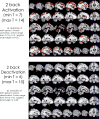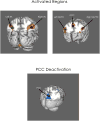Neural response to working memory demand predicts neurocognitive deficits in HIV
- PMID: 29280107
- PMCID: PMC6022366
- DOI: 10.1007/s13365-017-0607-z
Neural response to working memory demand predicts neurocognitive deficits in HIV
Abstract
Human immunodeficiency virus (HIV) continues to have adverse effects on cognition and the brain in many infected people, despite a reduced incidence of HIV-associated dementia with combined antiretroviral therapy (cART). Working memory is often affected, along with attention, executive control, and cognitive processing speed. Verbal working memory (VWM) requires the interaction of each of the cognitive component processes along with a phonological loop for verbal repetition and rehearsal. HIV-related functional brain response abnormalities during VWM are evident in functional MRI (fMRI), though the neural substrate underlying these neurocognitive deficits is not well understood. The current study addressed this by comparing 24 HIV+ to 27 demographically matched HIV-seronegative (HIV-) adults with respect to fMRI activation on a VWM paradigm (n-back) relative to performance on two standardized tests of executive control, attention and processing speed (Stroop and Trail Making A-B). As expected, the HIV+ group had deficits on these neurocognitive tests compared to HIV- controls, and also differed in neural response on fMRI relative to neuropsychological performance. Reduced activation in VWM task-related brain regions on the 2-back was associated with Stroop interference deficits in HIV+ but not with either Trail Making A or B performance. Activation of the posterior cingulate cortex (PCC) of the default mode network during rest was associated with Hopkins Verbal Learning Test-2 (HVLT-2) learning in HIV+. These effects were not observed in the HIV- controls. Reduced dynamic range of neural response was also evident in HIV+ adults when activation on the 2-back condition was compared to the extent of activation of the default mode network during periods of rest. Neural dynamic range was associated with both Stroop and HVLT-2 performance. These findings provide evidence that HIV-associated alterations in neural activation induced by VWM demands and during rest differentially predict executive-attention and verbal learning deficits. That the Stroop, but not Trail Making was associated with VWM activation suggests that attentional regulation difficulties in suppressing interference and/or conflict regulation are a component of working memory deficits in HIV+ adults. Alterations in neural dynamic range may be a useful index of the impact of HIV on functional brain response and as a fMRI metric in predicting cognitive outcomes.
Keywords: Attention; Executive control; Functional MRI; HIV; Stroop; Working memory.
Figures


Similar articles
-
Increased posterior cingulate cortex efficiency may predict cognitive impairment in asymptomatic HIV patients.Neuroradiol J. 2018 Aug;31(4):372-378. doi: 10.1177/1971400918782327. Epub 2018 Jun 13. Neuroradiol J. 2018. PMID: 29895218 Free PMC article.
-
Effects of HIV and childhood trauma on brain morphometry and neurocognitive function.J Neurovirol. 2016 Apr;22(2):149-58. doi: 10.1007/s13365-015-0379-2. Epub 2015 Sep 30. J Neurovirol. 2016. PMID: 26424107 Free PMC article.
-
Altered cortical-cerebellar circuits during verbal working memory in essential tremor.Brain. 2011 Aug;134(Pt 8):2274-86. doi: 10.1093/brain/awr164. Epub 2011 Jul 11. Brain. 2011. PMID: 21747127
-
The role of task-based neural activation research in understanding cognitive deficits in pediatric epilepsy.Epilepsy Behav. 2019 Oct;99:106332. doi: 10.1016/j.yebeh.2019.05.028. Epub 2019 Aug 6. Epilepsy Behav. 2019. PMID: 31399340 Review.
-
Exploring neural dysfunction in 'clinical high risk' for psychosis: a quantitative review of fMRI studies.J Psychiatr Res. 2015 Feb;61:122-34. doi: 10.1016/j.jpsychires.2014.08.018. Epub 2014 Sep 30. J Psychiatr Res. 2015. PMID: 25479766 Review.
Cited by
-
Robot-Based Assessment of HIV-Related Motor and Cognitive Impairment for Neurorehabilitation.IEEE Trans Neural Syst Rehabil Eng. 2021;29:576-586. doi: 10.1109/TNSRE.2021.3056908. Epub 2021 Mar 3. IEEE Trans Neural Syst Rehabil Eng. 2021. PMID: 33534709 Free PMC article.
-
Robot-based assessment of HIV-related motor and cognitive impairment for neurorehabilitation.medRxiv [Preprint]. 2020 Nov 3:2020.10.30.20223172. doi: 10.1101/2020.10.30.20223172. medRxiv. 2020. Update in: IEEE Trans Neural Syst Rehabil Eng. 2021;29:576-586. doi: 10.1109/TNSRE.2021.3056908. PMID: 33173932 Free PMC article. Updated. Preprint.
-
Neurofunctional characteristics of executive control in older people with HIV infection: a comparison with Parkinson's disease.Brain Imaging Behav. 2022 Aug;16(4):1776-1793. doi: 10.1007/s11682-022-00645-6. Epub 2022 Mar 16. Brain Imaging Behav. 2022. PMID: 35294979 Free PMC article.
-
Synergistic effects of marijuana abuse and HIV infection on neural activation during a cognitive interference task.Addict Biol. 2019 Nov;24(6):1235-1244. doi: 10.1111/adb.12678. Epub 2018 Sep 21. Addict Biol. 2019. PMID: 30239074 Free PMC article.
-
Neural mechanisms of internal distraction suppression in visual attention.Cortex. 2019 Aug;117:77-88. doi: 10.1016/j.cortex.2019.02.026. Epub 2019 Mar 6. Cortex. 2019. PMID: 30933692 Free PMC article.
References
-
- Cohen RA, Boland R, Paul R, et al. Neurocognitive performance enhanced by highly active antiretroviral therapy in HIV-infected women. AIDS. 2001;15(3):341–345. - PubMed
-
- Sacktor N, McDermott MP, Marder K, et al. HIV-associated cognitive impairment before and after the advent of combination therapy. J Neurovirol. 2002;8(2):136–142. - PubMed
-
- Clifford DB. HIV-associated neurocognitive disease continues in the antiretroviral era. Top HIV Med. 2008;16(2):94–98. - PubMed
MeSH terms
Grants and funding
LinkOut - more resources
Full Text Sources
Other Literature Sources
Medical
Research Materials

